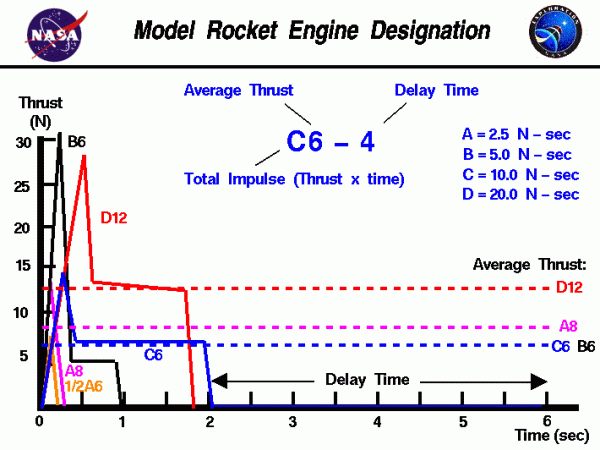Model Rocket Engine Designation

Flying Model Rockets
Flying model rockets is a relatively safe and inexpensive way for students to learn the basics of forces and the response of vehicles to external forces. Like an airplane, a model rocket is subjected to the forces of weight, thrust, and aerodynamics during its flight. The weight and aerodynamics are determined by the design of the model rocket components. The thrust is provided by a replaceable solid rocket engine which can be purchased at local hobby or toy stores.
Model Rocket Performance
Model rocket performance (how far, how high, how fast) depends a great deal on the rocket engine performance. There are several different ways to characterize rocket engine performance. Model rocket engines come in a variety of sizes and weights, with different amounts of propellant, with different burn patterns which effects the thrust profile, and with different values of the delay time.
Typical Performance Curves
At the top of the page, we show typical performance curves for several different rocket engines. We plot the thrust versus the time following ignition for each engine with solid lines. You will notice that when comparing engines, there is a great difference between the levels and shapes of the plots. For any single engine, the thrust changes with time. We can specify a time-averaged thrust of the engine by adding up the product of the thrust over some small-time increment times the amount of the time increment and then dividing by the total time. The result of this averaging is shown by the dashed lines on the plot.
Configuration of Each Engine
When purchasing model rocket engines, you will notice a label on each engine in the format; letter number – number. On the figure, we show a C6-4.
The first number indicates the average thrust in Newtons. A C6-4 has an average thrust of 6 Newtons. The average thrust times the burn time of the engine is called the total impulse of the engine. The letter gives the maximum total impulse of that class of engine. An “A” engine has a maximum impulse of 2.5 Newton-seconds, a “1/2A” has 1.25 N-sec, a “B” has 5.0 N-sec, a “C” has 10.0 N-sec, and a “D” has 20.0 N-sec. If we compare the curves for B6 and the C6, we find that both engines have the same average thrust (6 Newtons), but the “C” engine burns almost twice as long for double the total impulse. The second number indicates the length of the delay time in seconds. A C6-4 has a delay time of 4 seconds between the engine cutoff and the firing of the ejection charge. The delay time determines the length of the coasting phase of the flight. If the delay time is too short relative to the optimum coast of the vehicle, the parachute deploys on the way up and stops the flight. If the delay time is too long, the vehicle might hit the ground before the parachute deploys.
Interaction of Engine Design
The engine designer can affect the thrust and the total impulse of an engine by changing the diameter of the propellant (and casing). Typical “1/2A” engines are 13 mm in diameter, typical “A”, “B” and “C” engines are 18 mm in diameter, and typical “D” engines are 24 mm in diameter. This is important to remember because a model rocket designed for a “B” engine will not accept a “1/2A” or a “D”. The engines will not fit into the fixed engine mount of the rocket.
